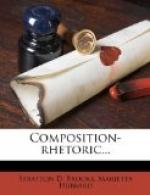+127. Selection of Essential Details.+—After deciding upon a point of view and such general characteristics as are essential to the forming of a correct outline of the object to be described, we must next give our attention to the selection of the details. If our description has been properly begun, this general outline will not be changed, but each succeeding phrase or sentence will add to the clearness and distinctness of the picture. Our first impression of a house may include windows, but the mention of them later will bring them out clearly on our mental picture much as the details appear when one is developing a negative in photography.
If the peculiarities of an object are such as to effect its general form, they need to be stated in the opening sentence; but when the peculiar or distinguishing characteristic does not affect the form, it may be introduced later. If we say, “On the corner across the street from the post office there is a large, two-story, red brick store,” the reader can form at once a general picture of such a store. Only those things which give a general outline have been included. As yet nothing has been mentioned to distinguish the store from any other similar one. If some following sentence should be, “Though not wider, it yet presents a more imposing appearance than its neighbors, because the door is placed at one side, thus making room for a single wide display window instead of two stuffy, narrow ones,” a detail has been added which, though not changing the general outline, makes the picture clearer and at the same time emphasizes the distinguishing feature of this particular store.
EXERCISES
1. Observe your neighbor’s barn. What would you select as its characteristic feature?
2. Take a rapid glance at some stranger whom you meet. What did you notice most vividly?
3. In what respect does the Methodist church in your city differ from the other church buildings?
4. Does your pet dog differ from others of the same breed in appearance? In actions?
+Theme LV.+—Write a descriptive paragraph, using one of the following subjects:—
1. A mountain view. 2. An omnibus. 3. A fort. 4. A lighthouse. 5. A Dutch windmill. 6. A bend in the river. 7. A peculiar structure. 8. The picture on this page.
(Underscore the sentence that pictures the details most essential to the description. Consider the unity of your paragraph. Section 81.)
[Illustration]
+128. Selection and Subordination of Minor Details.+—In many descriptions the minor details are wholly omitted, and in all descriptions many that might have been included have been omitted. A proper number of such details adds interest and clearness to the images; too many but serve to render the whole obscure. If properly selected and effectively presented, minor details add much to the beauty or usefulness of a description, but if strung together in short sentences, the effect may be both tiresome and confusing. A mere catalogue of facts is not a good description. They must be arranged so that those which are the more important shall have the greater prominence, while those of less importance shall be properly subordinated.




